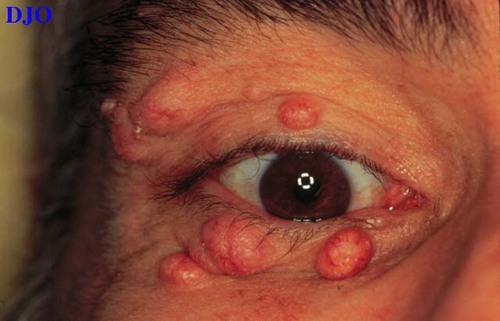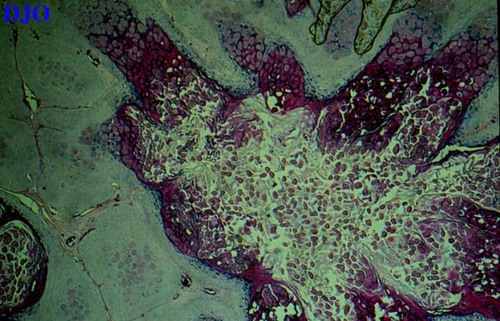Orbit/Oculoplastic Quiz 5

Figure 1
Figures 1-2. Clinical Photo and Histology.
Figures 1-2. Clinical Photo and Histology.

Figure 2
Answer: Molloscum contagiosum.
2. What is the characteristic clinical and histopathologic features of this lesion?
Answer: It is characterized by multiple, dome-shaped, skin-colored nodules usually measuring 1-3 mm in diameter. They are usually umbilicated, and a yellowish, cheesy material can be expressed FROM the center. Histologically, the epidermis shows invasive acanthosis that forms invaginated, pear shaped lobules. The virus replicates in the cytoplasm and is seen as large, homogeneous, purple, intracytoplasmic inclusion bodies (molluscum bodies) within a markedly acanthotic epidermis. In the deeper layers of the epidermis, near the basal layer, viruses are present as tiny, eosinophillic, intracytoplasmic inclusions. As the bodies extend toward the surface, they grow so enormous that they exceed the size of the invaded cells. At the epidermal layer the large bodies change FROM eosinophillic to basophillic.
3. What is the etiology of this lesion?
Answer: Molloscum contagiosum belongs to the large poxvirus group.
4. What is a consequence of this lesion?
Answer: If located on the lid margin, the viral particles can be liberated INTO the conjunctival cul-de-sac, often producing a follicular conjunctivitis.
5. What syndromes are associated with this lesion? Name two syndromes.
Answer: Wiskott-Aldrich syndrome. Characterized by atopic dermatitis, thrombocytopenic purpura, normal appearing megakaryocytes but small defective platelets, and increased susceptibility to infections. The syndrome represents an immunologically deficient state (decreased levels of serum IgM and increased levels of IgA and IgE) and is transmitted as an X-linked recessive trait (abnormal gene on Xp11-11.3 chromosome). Acquired immunodeficiency syndrome. Multiple eyelid lesions of molluscum may be seen.
6. What is the treatment of this lesion?
Answer: Observation, excision, controlled cryotherapy, or curettage.